Deck 4: Polynomial and Rational Functions
سؤال
سؤال
سؤال
سؤال
سؤال
سؤال
سؤال
سؤال
سؤال
سؤال
سؤال
سؤال
سؤال
سؤال
سؤال
سؤال
سؤال
سؤال
سؤال
سؤال
سؤال
سؤال
سؤال
سؤال
سؤال
سؤال
سؤال
سؤال
سؤال
سؤال
سؤال
سؤال
سؤال
سؤال
سؤال
سؤال
سؤال
سؤال
سؤال
سؤال
سؤال
سؤال
سؤال
سؤال
سؤال
سؤال
سؤال
سؤال
سؤال
سؤال
سؤال
سؤال
سؤال
سؤال
سؤال
سؤال
سؤال
سؤال
سؤال
سؤال
سؤال
سؤال
سؤال
سؤال
سؤال
سؤال
سؤال
سؤال
سؤال
سؤال
سؤال
سؤال
سؤال
سؤال
سؤال
سؤال
سؤال
سؤال
سؤال
سؤال

فتح الحزمة
قم بالتسجيل لفتح البطاقات في هذه المجموعة!
Unlock Deck
Unlock Deck
1/255
العب
ملء الشاشة (f)
Deck 4: Polynomial and Rational Functions
1
Find the y-intercept for the graph of the quadratic function.
A)
B)
C)
D)
A)
B)
C)
D)
D
2
Find the x-intercepts (if any)for the graph of the quadratic function.
A) and
B) and
C) and
D) and
A) and
B) and
C) and
D) and
A
3
Sketch the graph of the quadratic function.
A)
В)
C)
D)
A)
В)
C)
D)
A
4
Find the coordinates of the vertex of the quadratic function.
A)
B)
C)
D)
A)
B)
C)
D)

فتح الحزمة
افتح القفل للوصول البطاقات البالغ عددها 255 في هذه المجموعة.
فتح الحزمة
k this deck
5
Find the y-intercept for the graph of the quadratic function.
 A)
A)

B)
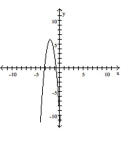
C)
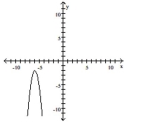
D)
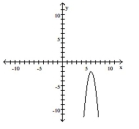
 A)
A)
B)

C)

D)


فتح الحزمة
افتح القفل للوصول البطاقات البالغ عددها 255 في هذه المجموعة.
فتح الحزمة
k this deck
6
Find the y-intercept for the graph of the quadratic function.
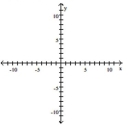
A)
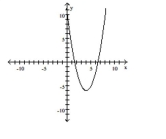
B)
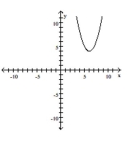
C)
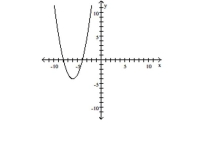
D)
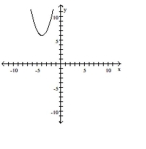

A)

B)

C)

D)


فتح الحزمة
افتح القفل للوصول البطاقات البالغ عددها 255 في هذه المجموعة.
فتح الحزمة
k this deck
7
Find the range of the quadratic function in interval notation.
A)
В)
C)
D)
A)
В)
C)
D)

فتح الحزمة
افتح القفل للوصول البطاقات البالغ عددها 255 في هذه المجموعة.
فتح الحزمة
k this deck
8
The logistic growth functi models the number of people who have become ill with a
A)
B)
C)
D)
A)
B)
C)
D)

فتح الحزمة
افتح القفل للوصول البطاقات البالغ عددها 255 في هذه المجموعة.
فتح الحزمة
k this deck
9
Find the range of the quadratic function in interval notation.
A)
B)
C) and
D) No x-intercepts
A)
B)
C) and
D) No x-intercepts

فتح الحزمة
افتح القفل للوصول البطاقات البالغ عددها 255 في هذه المجموعة.
فتح الحزمة
k this deck
10
The logistic growth functi describes the population of a species of butterflies t months
A)
B)
C)
D)
A)
B)
C)
D)

فتح الحزمة
افتح القفل للوصول البطاقات البالغ عددها 255 في هذه المجموعة.
فتح الحزمة
k this deck
11
Sketch the graph of the quadratic function.
A)
B)
C)
D)
A)
B)
C)
D)

فتح الحزمة
افتح القفل للوصول البطاقات البالغ عددها 255 في هذه المجموعة.
فتح الحزمة
k this deck
12
Find the coordinates of the vertex of the quadratic function.
A)
B)
C)
D)
A)
B)
C)
D)

فتح الحزمة
افتح القفل للوصول البطاقات البالغ عددها 255 في هذه المجموعة.
فتح الحزمة
k this deck
13
The logistic growth functi models the number of people who have become ill with a
A)
B)
C)
D)
A)
B)
C)
D)

فتح الحزمة
افتح القفل للوصول البطاقات البالغ عددها 255 في هذه المجموعة.
فتح الحزمة
k this deck
14
The logistic growth functi models the number of people who have become ill with a
A)
B)
C)
D)
A)
B)
C)
D)

فتح الحزمة
افتح القفل للوصول البطاقات البالغ عددها 255 في هذه المجموعة.
فتح الحزمة
k this deck
15
The logistic growth functi describes the population of a species of butterflies t months
A)
B)
C)
D)
A)
B)
C)
D)

فتح الحزمة
افتح القفل للوصول البطاقات البالغ عددها 255 في هذه المجموعة.
فتح الحزمة
k this deck
16
The logistic growth functi describes the population of a species of butterflies t months
A)
B)
C)
D)
A)
B)
C)
D)

فتح الحزمة
افتح القفل للوصول البطاقات البالغ عددها 255 في هذه المجموعة.
فتح الحزمة
k this deck
17
Find the coordinates of the vertex of the quadratic function.
A)
B)
C)
D)
A)
B)
C)
D)

فتح الحزمة
افتح القفل للوصول البطاقات البالغ عددها 255 في هذه المجموعة.
فتح الحزمة
k this deck
18
Sketch the graph of the quadratic function.
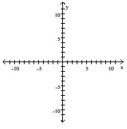
A)
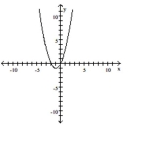
B)
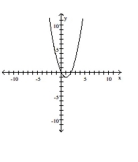
C)
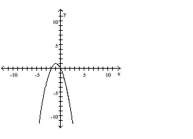
D)
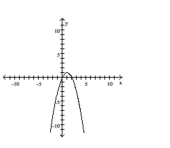

A)

B)

C)

D)


فتح الحزمة
افتح القفل للوصول البطاقات البالغ عددها 255 في هذه المجموعة.
فتح الحزمة
k this deck
19
The logistic growth functi models the number of people who have become ill with a
A)
B)
C)
D)
A)
B)
C)
D)

فتح الحزمة
افتح القفل للوصول البطاقات البالغ عددها 255 في هذه المجموعة.
فتح الحزمة
k this deck
20
The logistic growth functi models the number of people who have become ill with a
A)
B)
C)
D)
A)
B)
C)
D)

فتح الحزمة
افتح القفل للوصول البطاقات البالغ عددها 255 في هذه المجموعة.
فتح الحزمة
k this deck
21
Rewrite the quadratic function in standard form by completing the square.
A) No x-intercepts; No -intercepts
B) x-intercepts: and -intercept: 12
C) -intercepts: and -intercept:
D) No -intercepts; -intercept:
A) No x-intercepts; No -intercepts
B) x-intercepts: and -intercept: 12
C) -intercepts: and -intercept:
D) No -intercepts; -intercept:

فتح الحزمة
افتح القفل للوصول البطاقات البالغ عددها 255 في هذه المجموعة.
فتح الحزمة
k this deck
22
Find the axis of symmetry of the quadratic function.
A)
B)
C)
D)
A)
B)
C)
D)

فتح الحزمة
افتح القفل للوصول البطاقات البالغ عددها 255 في هذه المجموعة.
فتح الحزمة
k this deck
23
Find the axis of symmetry of the quadratic function.
A)
B)
C)
D)
A)
B)
C)
D)

فتح الحزمة
افتح القفل للوصول البطاقات البالغ عددها 255 في هذه المجموعة.
فتح الحزمة
k this deck
24
Find the axis of symmetry of the quadratic function.
A)
B)
C)
D)
A)
B)
C)
D)

فتح الحزمة
افتح القفل للوصول البطاقات البالغ عددها 255 في هذه المجموعة.
فتح الحزمة
k this deck
25
First rewrite the quadratic function in standard form by completing the square, then find any x-intercepts and any y-intercepts.
A)
B)
C)
D)
A)
B)
C)
D)

فتح الحزمة
افتح القفل للوصول البطاقات البالغ عددها 255 في هذه المجموعة.
فتح الحزمة
k this deck
26
Rewrite the quadratic function in standard form by completing the square.
Give your answers in exact form.
A) x-intercepts: and -intercept: 66
B) x-intercepts: and y-intercept:
C) x-intercepts: and -intercept: 66
D) -intercepts: -intercept:
Give your answers in exact form.
A) x-intercepts: and -intercept: 66
B) x-intercepts: and y-intercept:
C) x-intercepts: and -intercept: 66
D) -intercepts: -intercept:

فتح الحزمة
افتح القفل للوصول البطاقات البالغ عددها 255 في هذه المجموعة.
فتح الحزمة
k this deck
27
Rewrite the quadratic function in standard form by completing the square.
A) -intercepts: 6 and 4 ; No -intercepts
B) x-intercepts: 6 and -intercept:
C) -intercepts: and 3 ; -intercept:
D) -intercepts: and -intercept: 48
A) -intercepts: 6 and 4 ; No -intercepts
B) x-intercepts: 6 and -intercept:
C) -intercepts: and 3 ; -intercept:
D) -intercepts: and -intercept: 48

فتح الحزمة
افتح القفل للوصول البطاقات البالغ عددها 255 في هذه المجموعة.
فتح الحزمة
k this deck
28
Rewrite the quadratic function in standard form by completing the square.
A) -intercepts: 8 and -intercept: 17
B) -intercepts: and -intercept: 72
C) -intercepts: 8 and -intercept:
D) No x-intercepts; y-intercept:
A) -intercepts: 8 and -intercept: 17
B) -intercepts: and -intercept: 72
C) -intercepts: 8 and -intercept:
D) No x-intercepts; y-intercept:

فتح الحزمة
افتح القفل للوصول البطاقات البالغ عددها 255 في هذه المجموعة.
فتح الحزمة
k this deck
29
Find the axis of symmetry of the quadratic function.
A)
B)
C)
D)
A)
B)
C)
D)

فتح الحزمة
افتح القفل للوصول البطاقات البالغ عددها 255 في هذه المجموعة.
فتح الحزمة
k this deck
30
Rewrite the quadratic function in standard form by completing the square.
A) -intercepts: and 9 ; -intercept: 0
B) x-intercepts: 5 and -intercept:
C) -intercepts: and -intercept: 90
D) -intercepts: 5 and -intercept:
A) -intercepts: and 9 ; -intercept: 0
B) x-intercepts: 5 and -intercept:
C) -intercepts: and -intercept: 90
D) -intercepts: 5 and -intercept:

فتح الحزمة
افتح القفل للوصول البطاقات البالغ عددها 255 في هذه المجموعة.
فتح الحزمة
k this deck
31
First rewrite the quadratic function in standard form by completing the square, then find any x-intercepts and any y-intercepts.
Give your answers in exact form.
A) -intercepts: and -intercept: 0
B) x-intercepts: and -intercept: 4
C) -intercepts: and -intercept: 4
D) -intercepts: and -intercept: 0
Give your answers in exact form.
A) -intercepts: and -intercept: 0
B) x-intercepts: and -intercept: 4
C) -intercepts: and -intercept: 4
D) -intercepts: and -intercept: 0

فتح الحزمة
افتح القفل للوصول البطاقات البالغ عددها 255 في هذه المجموعة.
فتح الحزمة
k this deck
32
First rewrite the quadratic function in standard form by completing the square, then find any x-intercepts and any y-intercepts.
A)
B)
C)
D)
A)
B)
C)
D)

فتح الحزمة
افتح القفل للوصول البطاقات البالغ عددها 255 في هذه المجموعة.
فتح الحزمة
k this deck
33
Find the axis of symmetry of the quadratic function.
A)
B)
C)
D)
A)
B)
C)
D)

فتح الحزمة
افتح القفل للوصول البطاقات البالغ عددها 255 في هذه المجموعة.
فتح الحزمة
k this deck
34
Find the axis of symmetry of the quadratic function.
A)
B)
C)
D)
A)
B)
C)
D)

فتح الحزمة
افتح القفل للوصول البطاقات البالغ عددها 255 في هذه المجموعة.
فتح الحزمة
k this deck
35
Rewrite the quadratic function in standard form by completing the square.
A)
B)
C)
D)
A)
B)
C)
D)

فتح الحزمة
افتح القفل للوصول البطاقات البالغ عددها 255 في هذه المجموعة.
فتح الحزمة
k this deck
36
First rewrite the quadratic function in standard form by completing the square, then find any x-intercepts and any y-intercepts.
A)
B)
C)
D)
A)
B)
C)
D)

فتح الحزمة
افتح القفل للوصول البطاقات البالغ عددها 255 في هذه المجموعة.
فتح الحزمة
k this deck
37
Rewrite the quadratic function in standard form by completing the square.
A) -intercepts: and -intercept: 2
B) x-intercepts: and -2; y-intercept: 2
C) x-intercepts: 1 and 2; -intercept:
D) -intercepts: 1 and -2; -intercept: 0
A) -intercepts: and -intercept: 2
B) x-intercepts: and -2; y-intercept: 2
C) x-intercepts: 1 and 2; -intercept:
D) -intercepts: 1 and -2; -intercept: 0

فتح الحزمة
افتح القفل للوصول البطاقات البالغ عددها 255 في هذه المجموعة.
فتح الحزمة
k this deck
38
Find the axis of symmetry of the quadratic function.
A)
B)
C)
D)
A)
B)
C)
D)

فتح الحزمة
افتح القفل للوصول البطاقات البالغ عددها 255 في هذه المجموعة.
فتح الحزمة
k this deck
39
Rewrite the quadratic function in standard form by completing the square.
A)x-intercepts: 6; y-intercept: 36
B)No x-intercepts; y-intercept: 72
C)x-intercepts: -6; y-intercept: 36
D)x-intercepts: -6; y-intercept: 72
A)x-intercepts: 6; y-intercept: 36
B)No x-intercepts; y-intercept: 72
C)x-intercepts: -6; y-intercept: 36
D)x-intercepts: -6; y-intercept: 72

فتح الحزمة
افتح القفل للوصول البطاقات البالغ عددها 255 في هذه المجموعة.
فتح الحزمة
k this deck
40
Find the axis of symmetry of the quadratic function.
A)
B)
C)
D)
A)
B)
C)
D)

فتح الحزمة
افتح القفل للوصول البطاقات البالغ عددها 255 في هذه المجموعة.
فتح الحزمة
k this deck
41
First rewrite the quadratic function in standard form by completing the square, then find any x-intercepts and any y-intercepts.
A)
B)
C)
D)
A)
B)
C)
D)

فتح الحزمة
افتح القفل للوصول البطاقات البالغ عددها 255 في هذه المجموعة.
فتح الحزمة
k this deck
42
Graph the quadratic function using its vertex, axis of symmetry, and intercepts.
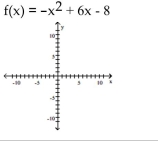 A) vertex
A) vertex
intercepts
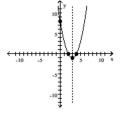
B) vertex
intercepts
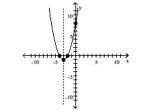
C) vertex
intercepts
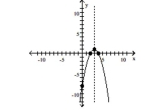
D) vertex
intercepts
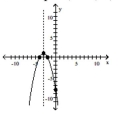
 A) vertex
A) vertex intercepts

B) vertex
intercepts

C) vertex
intercepts

D) vertex
intercepts


فتح الحزمة
افتح القفل للوصول البطاقات البالغ عددها 255 في هذه المجموعة.
فتح الحزمة
k this deck
43
Graph the quadratic function using its vertex, axis of symmetry, and intercepts.
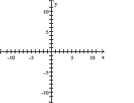
A) vertex
intercepts
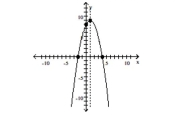
B) vertex
intercepts

C) vertex
intercepts
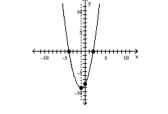
D) vertex
intercepts
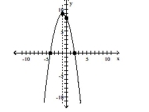

A) vertex
intercepts

B) vertex
intercepts

C) vertex
intercepts

D) vertex
intercepts


فتح الحزمة
افتح القفل للوصول البطاقات البالغ عددها 255 في هذه المجموعة.
فتح الحزمة
k this deck
44
Find the range of the quadratic function in interval notation.
A) minimum at
B) minimum at
C) maximum:
D) maximum at
A) minimum at
B) minimum at
C) maximum:
D) maximum at

فتح الحزمة
افتح القفل للوصول البطاقات البالغ عددها 255 في هذه المجموعة.
فتح الحزمة
k this deck
45
Graph the quadratic function using its vertex, axis of symmetry, and intercepts.
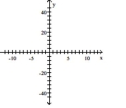
A) vertex
intercept
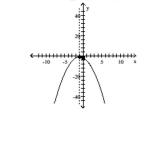
B) vertex
intercepts
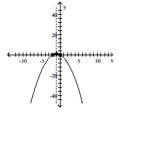
C) vertex
intercept
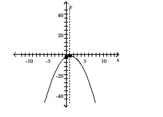
D) vertex
intercepts
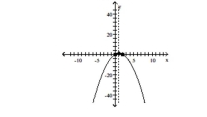

A) vertex
intercept

B) vertex
intercepts

C) vertex
intercept

D) vertex
intercepts


فتح الحزمة
افتح القفل للوصول البطاقات البالغ عددها 255 في هذه المجموعة.
فتح الحزمة
k this deck
46
Find the range of the quadratic function in interval notation.
A) maximum at
B) minimum at
C) maximum at
D) minimum at
A) maximum at
B) minimum at
C) maximum at
D) minimum at

فتح الحزمة
افتح القفل للوصول البطاقات البالغ عددها 255 في هذه المجموعة.
فتح الحزمة
k this deck
47
Find the range of the quadratic function in interval notation.
A) minimum at
B) maximum at
C) minimum; (ii)
D) maximum at
A) minimum at
B) maximum at
C) minimum; (ii)
D) maximum at

فتح الحزمة
افتح القفل للوصول البطاقات البالغ عددها 255 في هذه المجموعة.
فتح الحزمة
k this deck
48
Find the range of the quadratic function in interval notation.
A) minimum at
B) maximum at
C) maximum at
D) minimum at
A) minimum at
B) maximum at
C) maximum at
D) minimum at

فتح الحزمة
افتح القفل للوصول البطاقات البالغ عددها 255 في هذه المجموعة.
فتح الحزمة
k this deck
49
Graph the quadratic function using its vertex, axis of symmetry, and intercepts.
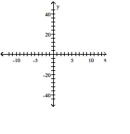
A) vertex
intercepts
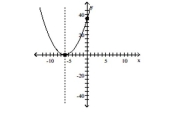
B) vertex
intercept
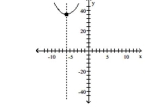
C) vertex
intercepts
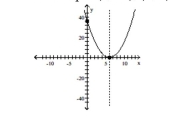
D) vertex
intercept
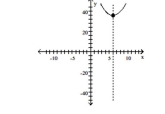

A) vertex
intercepts

B) vertex
intercept

C) vertex
intercepts

D) vertex
intercept


فتح الحزمة
افتح القفل للوصول البطاقات البالغ عددها 255 في هذه المجموعة.
فتح الحزمة
k this deck
50
Find the range of the quadratic function in interval notation.
A) minimum at
B) minimum at
C) maximum at
D) maximum at
A) minimum at
B) minimum at
C) maximum at
D) maximum at

فتح الحزمة
افتح القفل للوصول البطاقات البالغ عددها 255 في هذه المجموعة.
فتح الحزمة
k this deck
51
Find the range of the quadratic function in interval notation.
A) maximum at
B) minimum at
C) maximum at
D) minimum at
A) maximum at
B) minimum at
C) maximum at
D) minimum at

فتح الحزمة
افتح القفل للوصول البطاقات البالغ عددها 255 في هذه المجموعة.
فتح الحزمة
k this deck
52
Find the range of the quadratic function in interval notation.
A) maximum at (-2,-3)
B) minimum at
C) minimum at
D) maximum at
A) maximum at (-2,-3)
B) minimum at
C) minimum at
D) maximum at

فتح الحزمة
افتح القفل للوصول البطاقات البالغ عددها 255 في هذه المجموعة.
فتح الحزمة
k this deck
53
Graph the quadratic function using its vertex, axis of symmetry, and intercepts.
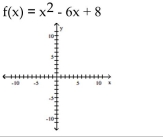 A) vertex
A) vertex
intercepts
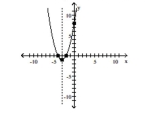
B) vertex
intercepts
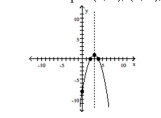
D) vertex
intercepts
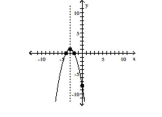
C) vertex
intercepts

 A) vertex
A) vertex intercepts

B) vertex
intercepts

D) vertex
intercepts

C) vertex
intercepts


فتح الحزمة
افتح القفل للوصول البطاقات البالغ عددها 255 في هذه المجموعة.
فتح الحزمة
k this deck
54
Find the range of the quadratic function in interval notation.
A) maximum at
B) minimum at
C) minimum at
D) maximum at
A) maximum at
B) minimum at
C) minimum at
D) maximum at

فتح الحزمة
افتح القفل للوصول البطاقات البالغ عددها 255 في هذه المجموعة.
فتح الحزمة
k this deck
55
Graph the quadratic function using its vertex, axis of symmetry, and intercepts.
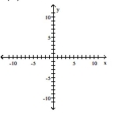
A) vertex
intercepts
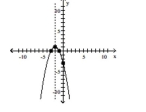
B) vertex
intercepts
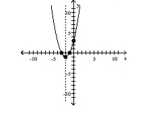
C) vertex
intercepts

D) vertex
intercepts
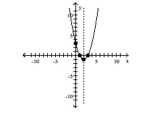

A) vertex
intercepts

B) vertex
intercepts

C) vertex
intercepts

D) vertex
intercepts


فتح الحزمة
افتح القفل للوصول البطاقات البالغ عددها 255 في هذه المجموعة.
فتح الحزمة
k this deck
56
Find the range of the quadratic function in interval notation.
A) minimum at
B) minimum at
C) maximum at
D) maximum at
A) minimum at
B) minimum at
C) maximum at
D) maximum at

فتح الحزمة
افتح القفل للوصول البطاقات البالغ عددها 255 في هذه المجموعة.
فتح الحزمة
k this deck
57
Graph the quadratic function using its vertex, axis of symmetry, and intercepts.

A) vertex
intercept
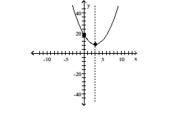
B) vertex
intercept
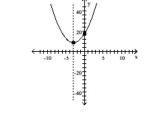
C) vertex
intercepts
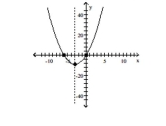
D) vertex
intercepts
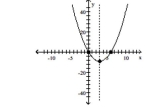

A) vertex
intercept

B) vertex
intercept

C) vertex
intercepts

D) vertex
intercepts


فتح الحزمة
افتح القفل للوصول البطاقات البالغ عددها 255 في هذه المجموعة.
فتح الحزمة
k this deck
58
Find the range of the quadratic function in interval notation.
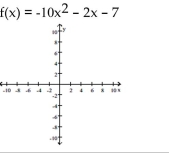 A) vertex
A) vertex
intercept
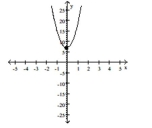
B) vertex
intercept
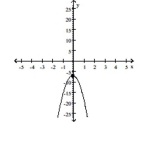
C) vertex
intercept
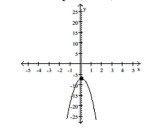
D) vertex
intercept
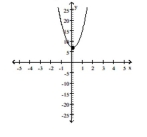
 A) vertex
A) vertex intercept

B) vertex
intercept

C) vertex
intercept

D) vertex
intercept


فتح الحزمة
افتح القفل للوصول البطاقات البالغ عددها 255 في هذه المجموعة.
فتح الحزمة
k this deck
59
Graph the quadratic function using its vertex, axis of symmetry, and intercepts.
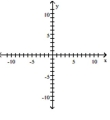
A) vertex
intercept
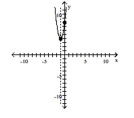
B) vertex
intercept
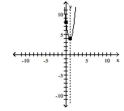
C) vertex
intercept
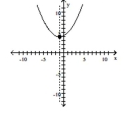
D) vertex
intercept
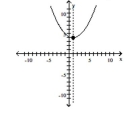

A) vertex
intercept

B) vertex
intercept

C) vertex
intercept

D) vertex
intercept


فتح الحزمة
افتح القفل للوصول البطاقات البالغ عددها 255 في هذه المجموعة.
فتح الحزمة
k this deck
60
Find the range of the quadratic function in interval notation.
A) minimum at
B) minimum at
C) maximum at
D) maximum at
A) minimum at
B) minimum at
C) maximum at
D) maximum at

فتح الحزمة
افتح القفل للوصول البطاقات البالغ عددها 255 في هذه المجموعة.
فتح الحزمة
k this deck
61
Write the equation of the function in the form f(x)= ax2 + bx + c.
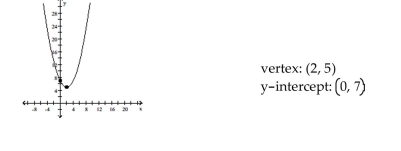
A)
B)
C)
D)

A)
B)
C)
D)

فتح الحزمة
افتح القفل للوصول البطاقات البالغ عددها 255 في هذه المجموعة.
فتح الحزمة
k this deck
62
Solve the problem.
Consider the quadratic model for the height (in feet), , of an object seconds after the object has been projected straight up into the air. Find the maximum height attained by the object. How much time does it take to fall back to the ground? Assume that it takes the same time for going up and coming down.
A)maximum height = 75 ft; time to reach ground = 2.5 seconds
B)maximum height = 50 ft; time to reach ground = 1.25 seconds
C)maximum height = 75 ft; time to reach ground = 1.25 seconds
D)maximum height = 50 ft; time to reach ground = 2.5 seconds
Consider the quadratic model for the height (in feet), , of an object seconds after the object has been projected straight up into the air. Find the maximum height attained by the object. How much time does it take to fall back to the ground? Assume that it takes the same time for going up and coming down.
A)maximum height = 75 ft; time to reach ground = 2.5 seconds
B)maximum height = 50 ft; time to reach ground = 1.25 seconds
C)maximum height = 75 ft; time to reach ground = 1.25 seconds
D)maximum height = 50 ft; time to reach ground = 2.5 seconds

فتح الحزمة
افتح القفل للوصول البطاقات البالغ عددها 255 في هذه المجموعة.
فتح الحزمة
k this deck
63
Solve the problem.
The owner of a video store has determined that the profits P of the store are approximately given by where x is the number of videos rented daily. Find the maximum profit to the nearest dollar.
A)$1312
B)$625
C)$1250
D)$687
The owner of a video store has determined that the profits P of the store are approximately given by where x is the number of videos rented daily. Find the maximum profit to the nearest dollar.
A)$1312
B)$625
C)$1250
D)$687

فتح الحزمة
افتح القفل للوصول البطاقات البالغ عددها 255 في هذه المجموعة.
فتح الحزمة
k this deck
64
Find the range of the quadratic function in interval notation.
A) minimum at
B) maximum at
C) minimum at
D) maximum at
A) minimum at
B) maximum at
C) minimum at
D) maximum at

فتح الحزمة
افتح القفل للوصول البطاقات البالغ عددها 255 في هذه المجموعة.
فتح الحزمة
k this deck
65
Solve the problem.
The owner of a video store has determined that the cost C, in dollars, of operating the store is approximately given by , where x is the number of videos rented daily. Find the lowest cost to the nearest dollar.
A)$698
B)$502
C)$208
D)$404
The owner of a video store has determined that the cost C, in dollars, of operating the store is approximately given by , where x is the number of videos rented daily. Find the lowest cost to the nearest dollar.
A)$698
B)$502
C)$208
D)$404

فتح الحزمة
افتح القفل للوصول البطاقات البالغ عددها 255 في هذه المجموعة.
فتح الحزمة
k this deck
66
Write the equation of the function in the form f(x)= ax2 + bx + c.
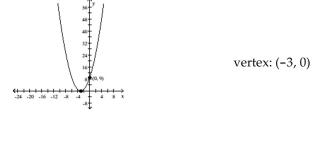
A)
B)
C)
D)

A)
B)
C)
D)

فتح الحزمة
افتح القفل للوصول البطاقات البالغ عددها 255 في هذه المجموعة.
فتح الحزمة
k this deck
67
Solve the problem.
A projectile is fired from a cliff 600 feet above the water at an inclination of to the horizontal, with a muzzle velocity of 120 feet per second. The height of the projectile above the water is given by , where is the horizontal distance of the projectile from the base of the cliff. How far from the base of the cliff is the height of the projectile a maximum?
A)712.5 ft
B)225 ft
C)937.5 ft
D)112.5 ft
A projectile is fired from a cliff 600 feet above the water at an inclination of to the horizontal, with a muzzle velocity of 120 feet per second. The height of the projectile above the water is given by , where is the horizontal distance of the projectile from the base of the cliff. How far from the base of the cliff is the height of the projectile a maximum?
A)712.5 ft
B)225 ft
C)937.5 ft
D)112.5 ft

فتح الحزمة
افتح القفل للوصول البطاقات البالغ عددها 255 في هذه المجموعة.
فتح الحزمة
k this deck
68
Use the quadratic function to determine if the function has a maximum or minimum value and then find this maximum or minimum value.
A) minimum at
B) minimum at
C) maximum at
D) maximum at
A) minimum at
B) minimum at
C) maximum at
D) maximum at

فتح الحزمة
افتح القفل للوصول البطاقات البالغ عددها 255 في هذه المجموعة.
فتح الحزمة
k this deck
69
Solve the problem.
The manufacturer of a CD player has found that the revenue R (in dollars)is when the unit price is p dollars. If the manufacturer sets the price p to maximize revenue, what is the maximum revenue to the nearest whole dollar?
A)$252,810
B)$1,011,240
C)$505,620
D)$126,405
The manufacturer of a CD player has found that the revenue R (in dollars)is when the unit price is p dollars. If the manufacturer sets the price p to maximize revenue, what is the maximum revenue to the nearest whole dollar?
A)$252,810
B)$1,011,240
C)$505,620
D)$126,405

فتح الحزمة
افتح القفل للوصول البطاقات البالغ عددها 255 في هذه المجموعة.
فتح الحزمة
k this deck
70
Write the equation of the function in the form f(x)= ax2 + bx + c.
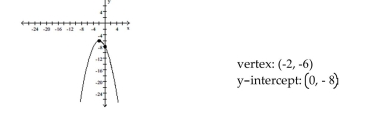
A)
B)
C)
D)

A)
B)
C)
D)

فتح الحزمة
افتح القفل للوصول البطاقات البالغ عددها 255 في هذه المجموعة.
فتح الحزمة
k this deck
71
Solve the problem.
The profit that the vendor makes per day by selling x pretzels is given by the function Find the number of pretzels that must be sold to maximize profit.
A)400 pretzels
B)170 pretzels
C)800 pretzels
D)0.8 pretzels
The profit that the vendor makes per day by selling x pretzels is given by the function Find the number of pretzels that must be sold to maximize profit.
A)400 pretzels
B)170 pretzels
C)800 pretzels
D)0.8 pretzels

فتح الحزمة
افتح القفل للوصول البطاقات البالغ عددها 255 في هذه المجموعة.
فتح الحزمة
k this deck
72
Write the equation of the function in the form f(x)= ax2 + bx + c.
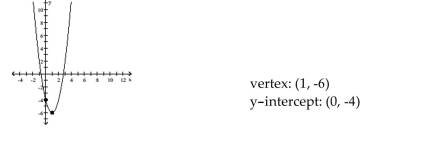
A)
B)
C)
D)

A)
B)
C)
D)

فتح الحزمة
افتح القفل للوصول البطاقات البالغ عددها 255 في هذه المجموعة.
فتح الحزمة
k this deck
73
Write the equation of the function in the form f(x)= ax2 + bx + c.
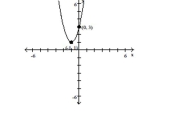
A)
B)
C)
D)

A)
B)
C)
D)

فتح الحزمة
افتح القفل للوصول البطاقات البالغ عددها 255 في هذه المجموعة.
فتح الحزمة
k this deck
74
Solve the problem.
A developer wants to enclose a rectangular grassy lot that borders a city street for parking. If the developer has 352 feet of fencing and does not fence the side along the street, what is the largest area that can be enclosed? A)
B)
C)
D)
A developer wants to enclose a rectangular grassy lot that borders a city street for parking. If the developer has 352 feet of fencing and does not fence the side along the street, what is the largest area that can be enclosed? A)
B)
C)
D)

فتح الحزمة
افتح القفل للوصول البطاقات البالغ عددها 255 في هذه المجموعة.
فتح الحزمة
k this deck
75
Write the equation of the function in the form f(x)= ax2 + bx + c.

A)
B)
C)
D)

A)
B)
C)
D)

فتح الحزمة
افتح القفل للوصول البطاقات البالغ عددها 255 في هذه المجموعة.
فتح الحزمة
k this deck
76
Find the range of the quadratic function in interval notation.
A) minimum at
B) maximum at
C) maximum at
D) minimum at
A) minimum at
B) maximum at
C) maximum at
D) minimum at

فتح الحزمة
افتح القفل للوصول البطاقات البالغ عددها 255 في هذه المجموعة.
فتح الحزمة
k this deck
77
Solve the problem.
You have 192 feet of fencing to enclose a rectangular region. Find the dimensions of the rectangle that maximize the enclosed area.
A)96 ft by 24 ft
B)96 ft by 96 ft
C)50 ft by 46 ft
D)48 ft by 48 ft
You have 192 feet of fencing to enclose a rectangular region. Find the dimensions of the rectangle that maximize the enclosed area.
A)96 ft by 24 ft
B)96 ft by 96 ft
C)50 ft by 46 ft
D)48 ft by 48 ft

فتح الحزمة
افتح القفل للوصول البطاقات البالغ عددها 255 في هذه المجموعة.
فتح الحزمة
k this deck
78
Use the quadratic function to determine if the function has a maximum or minimum value and then find this maximum or minimum value.
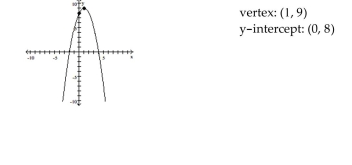
A)
B)
C)
D)

A)
B)
C)
D)

فتح الحزمة
افتح القفل للوصول البطاقات البالغ عددها 255 في هذه المجموعة.
فتح الحزمة
k this deck
79
Write the equation of the function in the form f(x)= ax2 + bx + c.
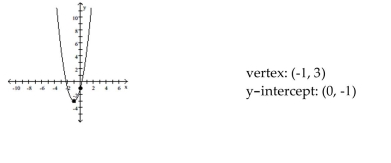
A)
B)
C)
D)

A)
B)
C)
D)

فتح الحزمة
افتح القفل للوصول البطاقات البالغ عددها 255 في هذه المجموعة.
فتح الحزمة
k this deck
80
Solve the problem.
A projectile is fired from a cliff 200 feet above the water at an inclination of to the horizontal, with a muzzle velocity of 380 feet per second. The height h of the projectile above the water is given by h , where is the horizontal distance of the projectile from the base of the cliff. Find the maximum height of the projectile.
A)2256.25 ft
B)3584.38 ft
C)1128.13 ft
D)1328.13 ft
A projectile is fired from a cliff 200 feet above the water at an inclination of to the horizontal, with a muzzle velocity of 380 feet per second. The height h of the projectile above the water is given by h , where is the horizontal distance of the projectile from the base of the cliff. Find the maximum height of the projectile.
A)2256.25 ft
B)3584.38 ft
C)1128.13 ft
D)1328.13 ft

فتح الحزمة
افتح القفل للوصول البطاقات البالغ عددها 255 في هذه المجموعة.
فتح الحزمة
k this deck








